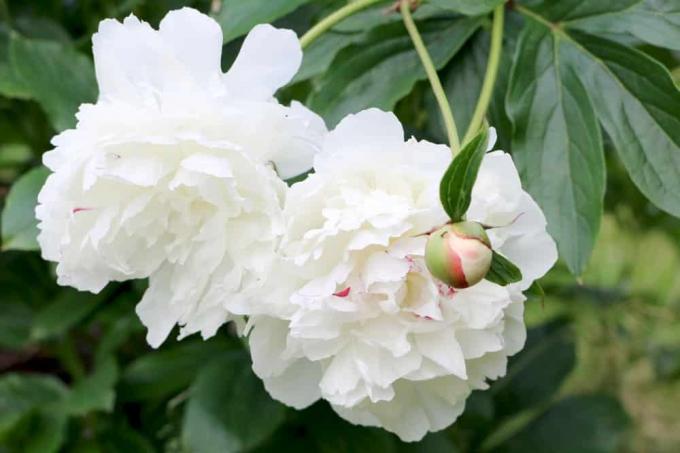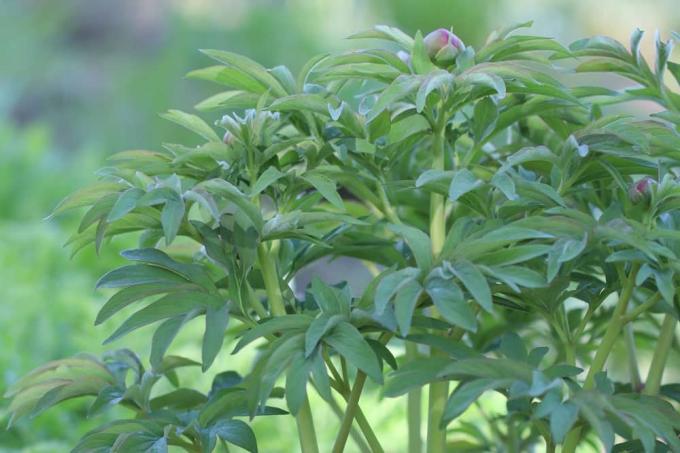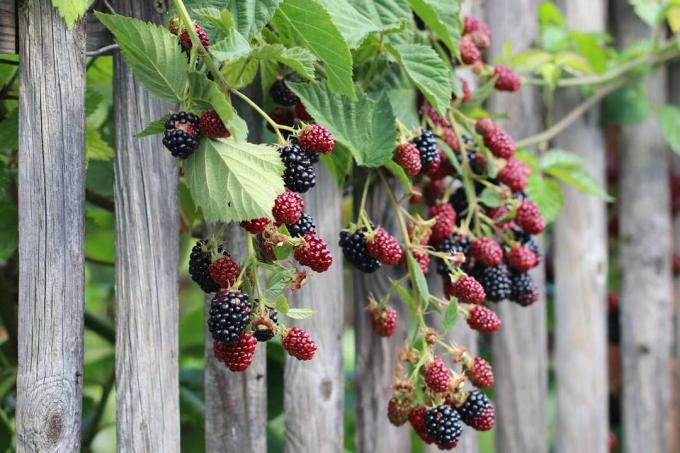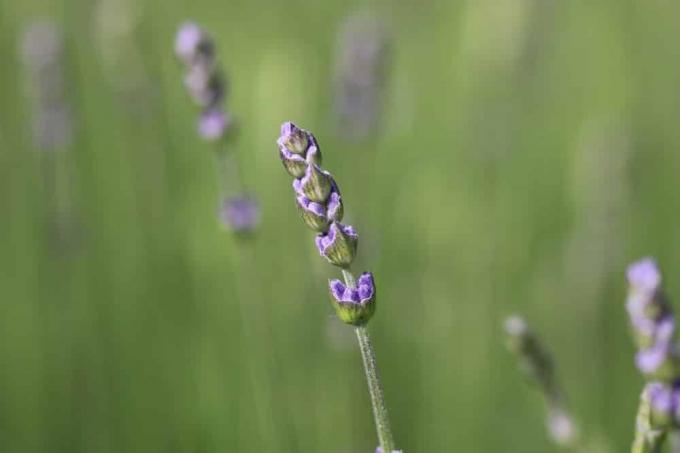

Table of contents
- Cut
- As cut flowers
- garden peonies
- tree peonies
- substrate and soil
- Location
- Plant
- multiply
- diseases and pests
- Conclusion
- Worth knowing shortly
With peonies (peonies) in the garden you always know exactly when summer begins. The hardy perennials produce numerous, wonderfully fragrant flowers every year, which are also popular as cut flowers, and require little maintenance to cultivate. However, they should be pruned regularly to stimulate flower growth and prevent possible diseases. Here are a few tips to give you the best care and pruning of your peonies so that you can enjoy them for a long time.
Cut
In general, sharp hedge or rose shears should be used to avoid crushing the plant stems. Do the pruning on a dry day so that no germs or dirt can penetrate the plant at the cutting points. Peonies are hardy, they don't need to be covered for the winter after cutting.
As cut flowers
The peony is an elegant, fragrant and long-lasting cut flower, the flowers of which are impressive as a single bouquet or in combination with other flowers. Cut off the flower stalks long, remove the leaves if there are any on the stalk, they rob the flower of its strength. If you want leafy greens, cut them extra. Always cut early in the morning in your own garden, make sure that the buds are not too small, otherwise they cannot open in the vase. The stems are cut at an angle and placed in lukewarm water. If desired, you can add summer flower food from specialist retailers. Place the vase in a draft-free place. Change the water and re-cut the flowers every two to three days. They should last at least 10 days.
garden peonies
When cutting outside in the garden, it is essential to distinguish between tree and garden peonies, the requirements are different here.
The perennials are cut in autumn, preferably October - November, so that the above-ground parts of the plant can retreat into the ground and rest over the winter. Garden peonies are cut back to a hand's breadth above the ground so that the dormant phase can begin. Cut the stalks piece by piece so that not too much pressure is put on the cutting points and sap is not released unnecessarily. Then the interfaces can quickly dry out and close. Examine the cut off parts of the plant to see if there is any fungal infestation. If this is the case, the clippings must not be disposed of in the compost, but must be disposed of in the household waste. At signs of fungus, cut close to the ground or just below the ground so you can be sure you don't miss any remnants.
tree peonies
If you remove the faded leaves with one or two leaves immediately after flowering, this will give the plant enough strength and not waste itself producing seeds. In the spring you can pinch back the young shoots to two or three eyes. More buds will form for the following year, and the plant will branch better.
The trees only get a cleaning cut in late autumn, i.e. November - December, if necessary. The shoots are cut back to the first bud, you should not touch sprouting buds. Before cutting, examine the branches and twigs to see if a cut is necessary at all. If your peony seems a bit bare to you, you can influence new growth with a cut. Cut to the first branch, if possible in front of an outside eye. However, avoid cutting in front of the inside eyes. Plants generally don't mind pruning, but it may take a year or two until it starts blooming again if you cut back the peony harder must.
- also remove the foliage of the tree peonies in the fall
- In the spring, cut off any wild shoots that sprout below the graft directly on the trunk
Tip:
If the tree peonies have frostbitten, only cut the frozen parts after they have sprouted. This way you can see which shoots have died. Below are a few tips for cultivating your peonies, so that you can enjoy the wonderful splendor and abundance of flowers from your peonies every year.
substrate and soil

Loose, humus rich soil is preferred. Deep soil is important, roots reach deep into the earth and branch out there.
- When inserting the young shrubs, add horn shavings to the excavation, this saves fertilizer in the first year.
- Place the grafting point for tree peonies at least 5 - 10 cm below the ground.
- Make sure that the eyes of perennial peonies are at least 3 cm below the ground.
Location
Peonies are site-loyal and want a wind-protected, sunny place where they can stay for several decades. Among gardeners, the peony is also called the favorite plant of the lazy gardener. She doesn't like being implemented.
Plant
Peonies are available as perennials and shrubs. As a rule, they are planted in the fall.
Tip:
Never put new peonies in a place where a peony has already stood, due to soil fatigue it will not develop properly and will only die. Even replacing the soil does not bring any improvement at this point.
multiply
Should the perennials become too large or for another reason a relocation of the local plant is unavoidable be, the whole perennial may not be moved to its new location, it is divided and like a young perennial treated. In this way, propagation can take place by division.
diseases and pests
Under certain circumstances, the undemanding plants can contract fungal diseases, which is shown by withered branches and stems during the growing season. In these cases of perennials, pull out the affected stems directly at the roots and cut them off deeply in the autumn. Do not dispose of in the compost. Tree peonies should be pruned back to healthy wood to eradicate the fungus.
Conclusion
The undemanding and long-lived peonies are an enrichment for every garden that your grandchildren can still enjoy. By pruning back in autumn, the perennial gains new strength and rewards the little effort with an enormous abundance of flowers and an enchanting fragrance. Put your peonies in a sunny spot and the plant will thank you every year.
Worth knowing shortly
- Basically, the branches and leaves should only be cut back carefully. The rule here is: less is more.
- It is very important to use quality pruning shears that are very sharp.
- It is always cut off above the so-called "sleeping buds" - shoots that only sprout in the next growth phase.

In absolutely exceptional cases, a peony can also be severely cut back: but only as exceptional cases Situations where disease is present or the peony is massively damaged by a storm or frost damage became. After such a radical pruning, it may happen that flowering fails for a year. So don't be surprised if the peony doesn't sprout for a season and looks rather miserable. In any case, it should be left where it is, as it will recover on its own.
- In the case of a massive pruning, it is also important that a miracle sealing agent is applied to the cuts.
- This prevents fungi or other diseases from getting into the bush via the interfaces.
- Such miracle closures can be bought in any well-stocked hardware store or you can look around in various online shops on the Internet.
- Because peonies don't form strong stems, it makes sense to get good pruning shears.
- Alternatively, you can also rent gardening tools in many DIY stores or garden shops.
 garden editorial
garden editorial I write about everything that interests me in my garden.
Learn more about pruning

Eucalyptus dried up: cut back now?
When a eucalyptus dries up, some owners immediately think of cutting it back. Because they want to see fresh green bud quickly. The chances of that happening may be good. But one thing must not be left out: research into the causes! Otherwise a new cycle of drying up and cutting begins.

Cut blackberries: Instructions for the right cut
Bramble branches only bear fruit for one summer, after which they are used up and die off in winter. It's a good thing that new canes grow back in time for the following year. Cutting care means: What no longer supports should be removed, young rods must be optimally trained.

cutting snowball | 13 tips for pruning
When it comes to snowballs (Viburnum), the opinions of numerous hobby gardeners differ when it comes to cutting. Main reason against pruning: Destruction of the natural appearance by pruning. Find out now when it is unavoidable and which tips should be heeded.

Cutting sage: 6 tips for cutting back
Cutting measures and their ideal time depend on the species of sage plants, because they have differentiated ways of life. There are woody and herbaceous representatives that require different attention. In order to carry out the measures, a basic set of tools is helpful.

Pruning hydrangeas: when is the right time?
Hydrangeas are a real beauty because of their flowers. In the long term, however, the flowering power is only maintained if regular pruning takes place. Because cutting off withered or dried plant parts offers protection. The following guide shows when this measure should be taken.

Cutting Lavender | When is the best time?
Lavender is a popular perennial, but difficult to cut. Without regular pruning, the shrub becomes lignified and less robust. Choosing the right time is important for pruning. When to cut depends on the use of the perennials.
